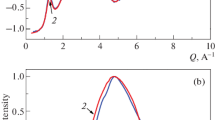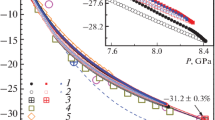Abstract
High-precision studies of the volume and the electrical resistivity of g-As2Te3 glasses at a high hydrostatic pressure up to 8.5 GPa at room temperature are performed. The glasses exhibit elastic behavior in compression only at a pressure up to 1 GPa, and a diffuse structural transformation and inelastic density relaxation (logarithmic in time) begin at higher pressures. When the pressure increases further, the relaxation rate passes through a sharp maximum at 2.5 GPa, which is accompanied by softening the relaxing bulk modulus, and then decreases, being noticeable up to the maximum pressure. When pressure is relieved, an unusual inflection point is observed in the baric dependence of the bulk modulus near 4 GPa. The polyamorphic transformation is only partly reversible and the residual densification after pressure release is 2%. In compression, the electrical resistivity of the g-As2Te3 glasses decreases exponentially with increasing pressure (at a pressure up to 2 GPa); then, it decreases faster by almost three orders of magnitude in the pressure range 2–3.5 GPa. At a pressure of 5 GPa, the electrical resistivity reaches 10–3 Ω cm, which is characteristic of a metallic state; this resistivity continues to decrease with increasing pressure and reaches 1.7 × 10–4 Ω cm at 8.1 GPa. The reverse metal–semiconductor transition occurs at a pressure of 3 GPa when pressure is relieved. When the pressure is decreased to atmospheric pressure, the electrical resistivity of the glasses is below the initial pressure by two–three orders of magnitude. Under normal conditions, both the volume and the electrical resistivity relax to quasi-equilibrium values in several months. Comparative structural and Raman spectroscopy investigations demonstrate that the glasses subjected to high pressure have the maximum chemical order. The glasses with a higher order have a lower electrical resistivity. The polyamorphism in the As2Te3 glasses is caused by both structural changes and chemical ordering. The g-As2Te3 compound is the first example of glasses, where the reversible metallization under pressure has been studied under hydrostatic conditions.
Similar content being viewed by others
References
M. Wuttig and N. Yamada, Nat. Mater. 6, 824 (2007).
J. Cornet and D. Rossier, J. Non-Cryst. Solids 12, 85 (1973).
Q. Ma, D. Raoux and S. Benazeth, Phys. Rev. B 48, 16332 (1993).
K. Abe, O. Uemura, T. Usuki, et al., J. Non-Cryst. Solids 232–234, 682 (1998).
G. Faigel, L. Granasy, I. Vincze, and H. de Waard, J. Non-Cryst. Solids 57, 411 (1983).
P. Jóvári, S. N. Yannopoulos, I. Kaban, et al., J. Chem. Phys. 129, 214502 (2008).
S. Sen, S. Joshi, B. G. Aitken, and S. Khalid, J. Non-Cryst. Solids 354, 4620 (2008).
A. Tverjanovich, K. Rodionov, and E. Bychkov, J. Solid State Chem. 190, 271 (2012).
D. C. Kaseman, I. Hung, K. Lee, et al., J. Phys. Chem. B 119, 2081 (2015).
M. Dongol, T. Gerber, M. Hafiz, et al., J. Phys.: Condens. Matter 18, 6213 (2006).
T. G. Edwards, E. L. Gjersing, S. Sen, et al., J. Non-Cryst. Solids 357, 3036 (2011).
M. Tenhover, P. Boolchand, and W. J. Bresser, Phys. Rev. B 27, 7533 (1983).
S. S. K. Titus, R. Chatterjee, S. Asokan, and A. Kumar, Phys. Rev. B 48, 14650 (1993).
S. Sen, S. Soyer Uzun, C. J. Benmore, and B. J. Aitken, J. Phys.: Condens. Matter 22, 405401 (2010).
A. Tverjanovich, M. Yagodkina, and V. Strykanov, J. Non-Cryst. Solids 223, 86 (1998).
H. Endo, H. Hoshino, H. Ikemoto, and T. Miyanaga, J. Phys.: Condens. Matter 12, 6077 (2000).
C. Otjacques, J. Raty, F. Hippert, et al., Phys Rev. B 82, 054202 (2010).
G. Parthasarathy and E. S. R. Gopal, Bull. Mater. Sci. 7, 271 (1985).
S. Minomura, in Amorphous Semiconductors: Technologies and Devices, Ed. by Y. Hamakawa (North Holland, Amsterdam, 1978), p. 245.
N. Sakai and H. Fritzsche, Phys. Rev. B 15, 973 (1977).
I. V. Berman, N. V. Brandt, I. E. Kostyleva, et al., JETP Lett. 43, 62 (1986).
G. Ramani, A. Giridhar, and A. K. Singh, Philos. Mag. B 39, 385 (1979).
J. Kristofic, J. J. Mares, and V. Smid, Phys. Status Solidi A 89, 333 (1985).
K. Ramesh, J. Phys. Chem. B 118, 8848 (2014).
C. J. Benmore and A. K. Soper, The SANDALS Manual: A Guide to Performing Experiments on the Small Angle Neutron Diffractometer for Amorphous and Liquid Samples at ISIS (Rutherford-Appleton Labor., 1998).
A. C. Hannon, W. S. Howells, and A. K. Soper, Inst. Phys. Conf. Ser. 107, 193 (1990).
O. L. G. Alderman, M. Liška, J. Macháček, et al., J. Phys. Chem. C 120, 553 (2016).
A. P. Hammersley, S. O. Svensson, M. Hanfland, et al., High Press. Res. 14, 235 (1996).
C. N. J. Wagner, J. Non-Cryst. Solids 31, 1 (1978).
L. B. Skinner, C. J. Benmore, and J. B. Parise, Nucl. Instr. Methods Phys. Res. A 662, 61 (2012).
L. G. Khvostantsev, V. N. Slesarev, and V. V. Brazhkin, High Press. Res. 24, 371 (2004).
O. B. Tsiok, V. V. Bredikhin, V. A. Sidorov, and L. G. Khvostantsev, High Press. Res. 10, 523 (1992).
O. B. Tsiok, V. V. Brazhkin, A. G. Lyapin, and L. G. Khvostantsev, Phys. Rev. Lett. 80, 999 (1998).
V. V. Brazhkin, E. Bychkov, and O. B. Tsiok, Phys. Chem. B 120, 358 (2016).
V. V. Brazhkin, O. B. Tsiok, and J. Katayama, JETP Lett. 89, 244 (2009).
V. V. Struzhkin, A. F. Goncharov, R. Caracas, et al., Phys. Rev. B 77, 165133 (2008).
D. J. E. Mullen and W. Nowacki, Z. Kristallogr. 136, 48 (1972).
A. R. Kampf, R. T. Downs, R. M. Housley, et al., Miner. Mag. 75, 2857 (2011).
A. C. Stergiou and P. J. Rentzeperis, Z. Kristallogr. 173, 185 (1985).
E. Lorch, J. Phys. C 2, 229 (1969).
J. S. Lannin, Phys. Rev. B 15, 3863 (1977).
J. R. Magana and J. S. Lannin, Phys. Rev. Lett. 51, 2398 (1983).
A. Mendoza-Galvan, E. Garcıa-Garcıa, Y. V. Vorobieva, and J. Gonzalez-Hernandez, Microelectron. Eng. 51–52, 677 (2000).
S. I. Simdyankin, S. R. Elliott, Z. Hajnal, et al., Phys. Rev. B 69, 144202 (2004).
G. J. Carron, Acta Crystallogr. 16, 338 (1963).
A. S. Kanishcheva, Yu. N. Mikhailov, and A. P. Chernov, Neorg. Mater. 18, 949 (1982).
A. C. Stergiou and P. J. Rentzeperis, Z. Kristallogr. 172, 139 (1985).
C. Morin, S. Corallini, J. Carreaud, et al., Inorg. Chem. 54, 9936 (2015).
M. Deli, D. Houphouet Boigny, and G. Kra, J. Non-Oxide Glasses 1, 59 (2010).
T. E. Faber and J. M. Ziman, Philos. Mag. 11, 153 (1965).
Author information
Authors and Affiliations
Corresponding author
Additional information
Original Russian Text © V.V. Brazhkin, E. Bychkov, O.B. Tsiok, 2017, published in Zhurnal Eksperimental’noi i Teoreticheskoi Fiziki, 2017, Vol. 152, No. 3, pp. 530–546.
Rights and permissions
About this article
Cite this article
Brazhkin, V.V., Bychkov, E. & Tsiok, O.B. High-precision measurements of the compressibility and the electrical resistivity of bulk g-As2Te3 glasses at a hydrostatic pressure up to 8.5 GPa. J. Exp. Theor. Phys. 125, 451–464 (2017). https://doi.org/10.1134/S1063776117080155
Received:
Published:
Issue Date:
DOI: https://doi.org/10.1134/S1063776117080155




